là một chương trình vẽ vector, thường được sử dụng để vẽ hình minh hoạ, hoạt hình, biểu đồ, đồ thị. Adobe Illustrator được dùng để thiết kế : như thiết kế những sản phẩm trong ngành thiết kế quảng cáo, thiết kế in ấn, thiết kế logo, thiết kế bản hiệu, thiết kế thời trang, thiết kế thiệp mời, Tạo các sản phẩm tờ rơi, Cataloge, Card Visit, Broucher, Profile,vẽ hoạt hình, tích hợp chuyển động cho Flash...Adobe Illustrator ưu diểm là dễ dàng thay đổi và trao đổi dữ liệu ,kích thước file nhẹ, dễ dàng tương thích với Photoshop, Corel Draw, và hỗ trợ in ấn rất tốt.
Hôm nay, trung tâm TIN HỌC KEY xin giới thiệu đến các bạn một hệ thống bài tập thực hành vẽ các đối tượng trong Adobe illustrator (Ai) (phiên bản tiếng anh, theo: vectips.com) có hướng dẫn chi tiết các bước thực hiện cụ thể để các bạn dễ dàng thực hành theo. Hôm nay chúng ta sẽ học bài 15: How To Create a Stunning Diamond Icon In 17 Short Steps. Hy vọng hệ thống bài học này sẽ mang lại cho bạn những kiến thức hữu ích trong quá trình bạn học Adobe illustrator (Ai).
Chúc các bạn thành công!
How To Create a Stunning Diamond Icon In 17 Short Steps
Final Image
As always, this is the final image that we’ll be creating:
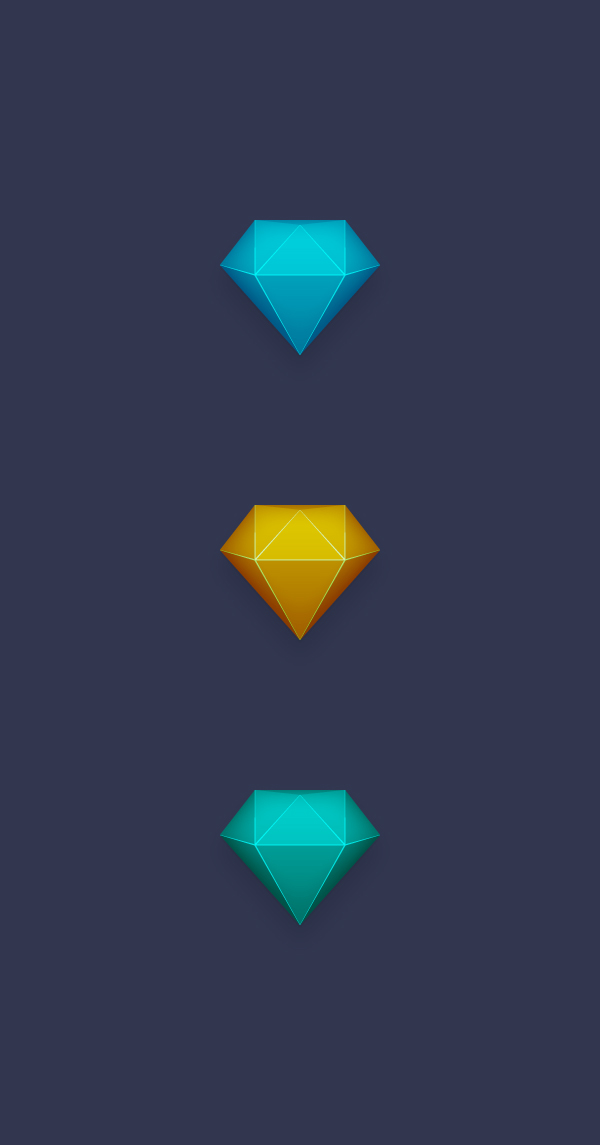
Step 1
Hit Control + N to create a new document. Select Pixels from the Units drop-down menu, enter 600 in the width and height boxes, then click on theAdvanced button. Select RGB, Screen (72ppi) and make sure that the Align New Objects to Pixel Grid box is unchecked before you click OK. Enable the Grid (View > Show Grid) and the Snap to Grid (View > Snap to Grid). You will need a grid every 5px, so simply go to Edit > Preferences > Guides > Grid, enter 5 in the Gridline every box and 1 in the Subdivisions box. You should also open the Info panel (Window > Info) for a live preview with the size and position of your shapes. Do not forget to set the unit of measurement to pixels from Edit > Preferences > Units > General. All these options will significantly increase your work speed.
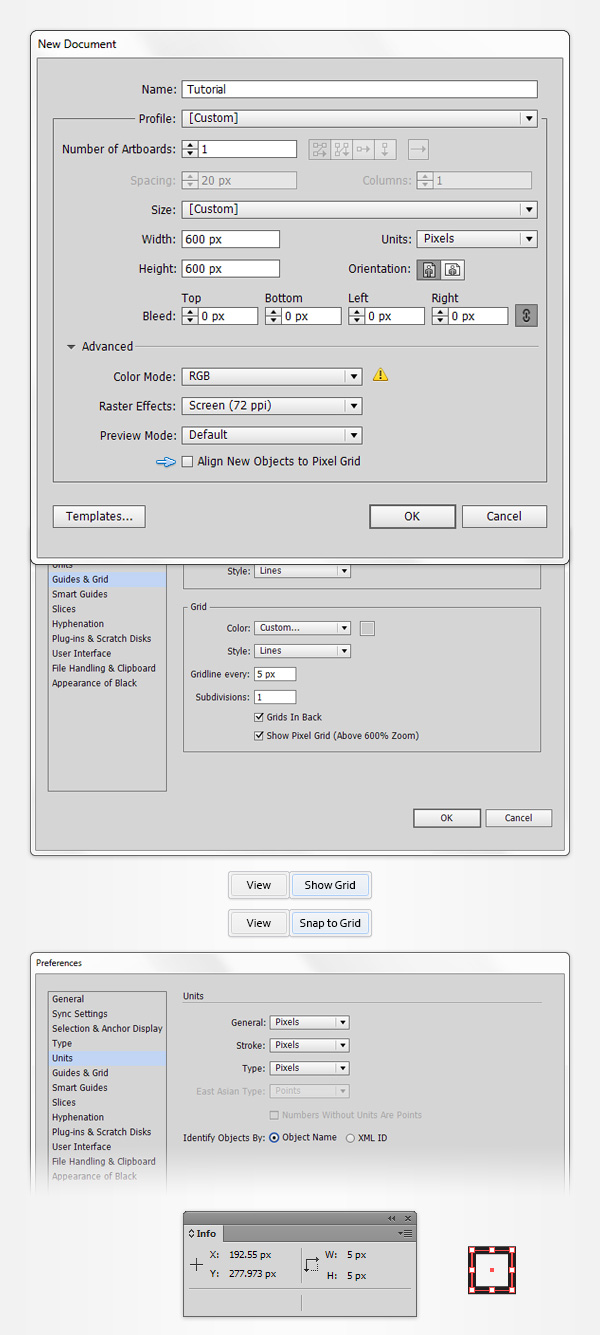
Step 2
Pick the Rectangle Tool (M) and focus on your Toolbar. Remove the color from the stroke. Then select the fill and set its color at R=39 G=170 B=225. Move to your artboard and simply create a 90 x 80px rectangle. Switch to the Direct Selection Tool (A), focus on the bottom side of your blue rectangle, select both anchor points and hit Alt + Control + J (or go to Object > Path > Average). Check the Both box then click OK. This should turn your rectangle into a simple triangle as shown in the second image.
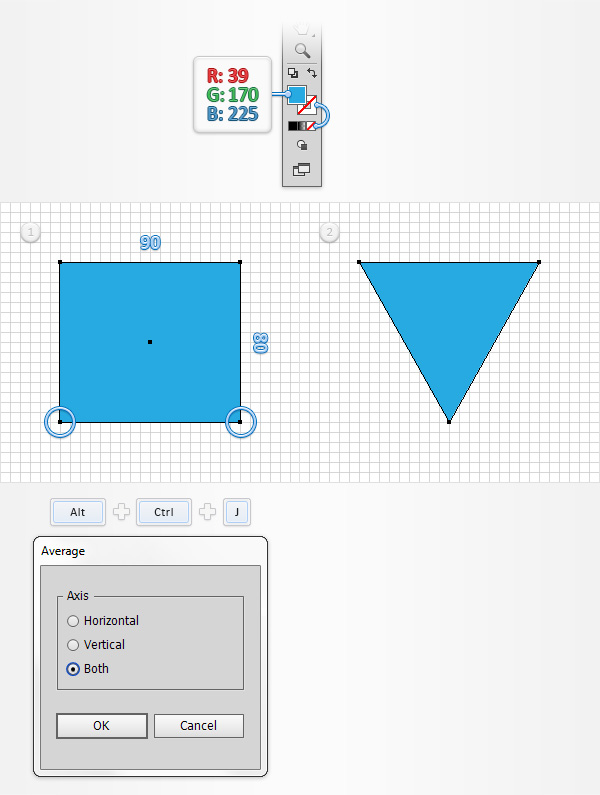
Step 3
Using the Rectangle Tool (M), create a 90 x 50px shape, set the fill color at R=255 G=222 B=23 and place it as shown in the first image. Switch to the Direct Selection Tool (A), focus on the top side of your yellow rectangle, select both anchor points and hit Alt + Control + J. Again, check theBoth box, then click OK. Focus on the top side of your yellow triangle and reselect the Rectangle Tool (M). Create a 90 x 5px shape, set the fill color at R=102 G=45 B=145 and place it as shown in the third image. Switch to the Direct Selection Tool (A), focus on the bottom side of your purple rectangle, select both anchor points and hit Alt + Control + J. Once again, check the Both box then click OK.
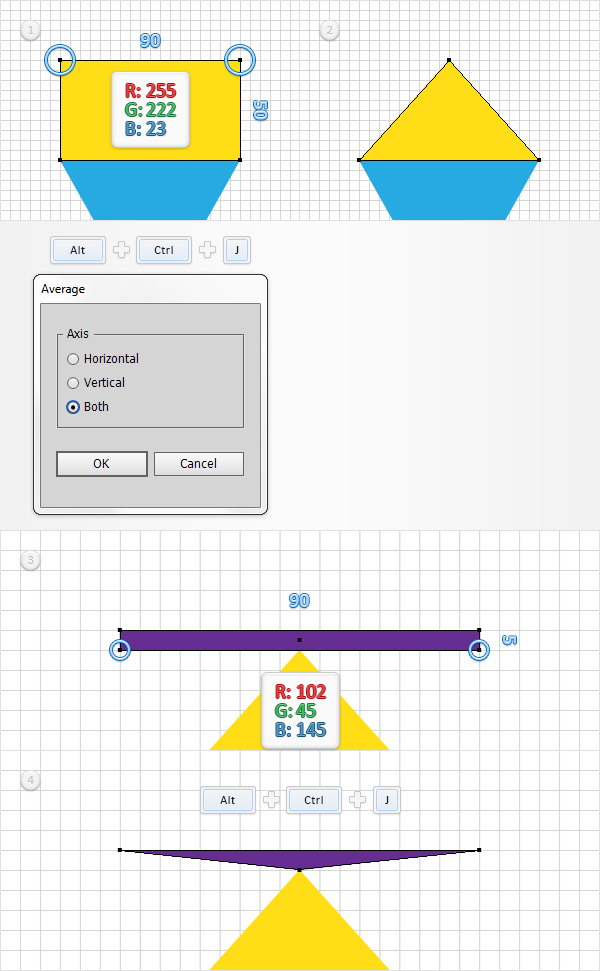
Step 4
Using the Rectangle Tool (M), create an 80 x 90px shape, set the fill color at R=247 G=148 B=30 and place it as shown in the first image. Focus on this new shape, grab the Delete Anchor Point Tool (-) and simply click on the bottom, right anchor point to remove it. Switch to the Direct Selection Tool (A) and focus on the top side of your orange shape. Select the left anchor point and simply drag it 10px down and 45px to the right. In the end, things should look like in the second image.

Step 5
Reselect your orange shape and go to Effect > Distort & Transform > Transform. Check the Reflect X box, drag the Move – Horizontal slider at-80px, enter 1 in the Copies box, then click the OK button. Make sure that your orange shape is still selected and go to Object > Expand Appearance. Select the resulting group of shapes and simply hit Shift + Control + G to Ungroup it.
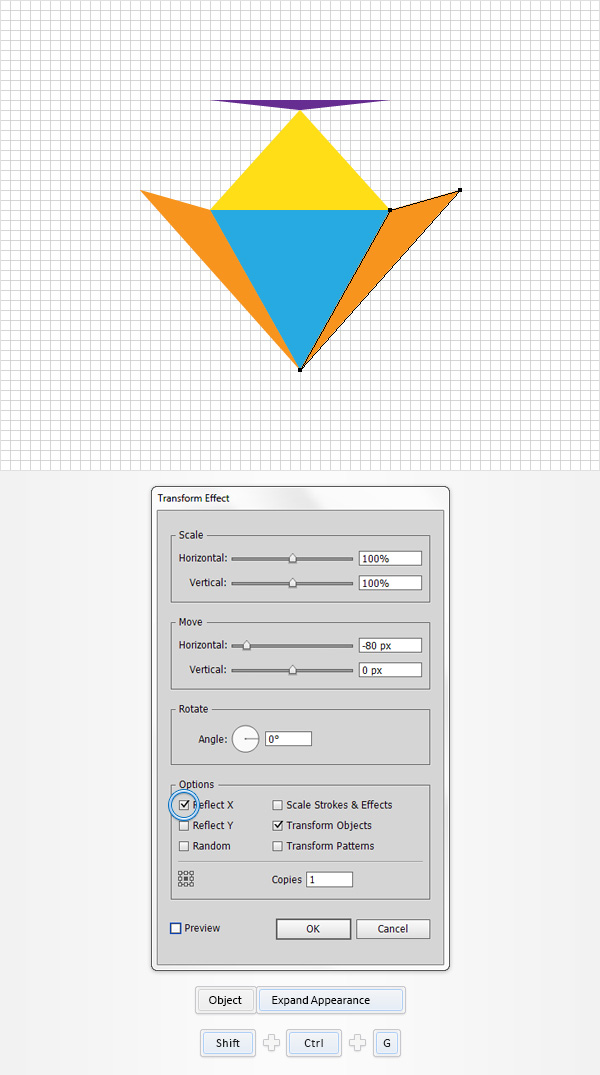
Step 6
Using the Rectangle Tool (M), create an 45 x 55px shape, set the fill color at R=141 G=198 B=63 and place it as shown in the first image. Focus on this new shape, grab the Delete Anchor Point Tool (-) and simply remove the top, left anchor point (highlighted by the red circle). Switch to theDirect Selection Tool (A) and focus on the bottom side of your green shape. Select the left anchor point and simply drag it 50px up. In the end, things should look like in the second image. Reselect your green shape, make a copy in front (Control + C > Control + F), select the copy and move it45px to the left as shown in the third image. Make sure that the copy stays selected, pick the Reflect Tool (O). Then simply click and drag from the right side to the left side of your shape to flip it as shown in the fourth image.
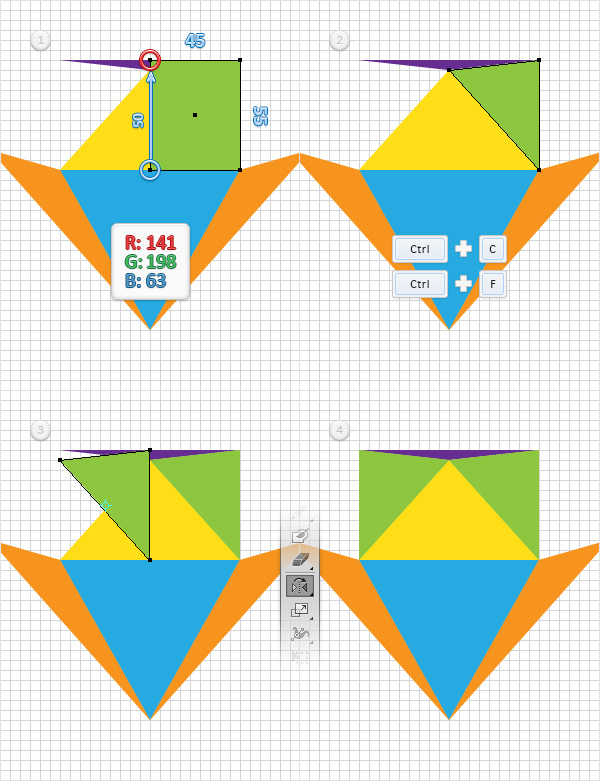
Step 7
Using the Rectangle Tool (M), create a 35 x 55px shape, set the fill color at R=237 G=28 B=36 and place it as shown in the first image. Focus on this new shape, grab the Delete Anchor Point Tool (-) and simply remove the bottom, right anchor point (highlighted by the red circle). Switch to theDirect Selection Tool (A) and focus on the top side of your red shape. Select the right anchor point and simply drag it 45px down. In the end, things should look like in the second image. Make sure that your red shape is still selected and go to Object > Transform > Reflect. Check the Vertical box, then simply click the Copy button. Focus on your artboard, select the newly created shape, drag it to the left and place it as shown in the third image.
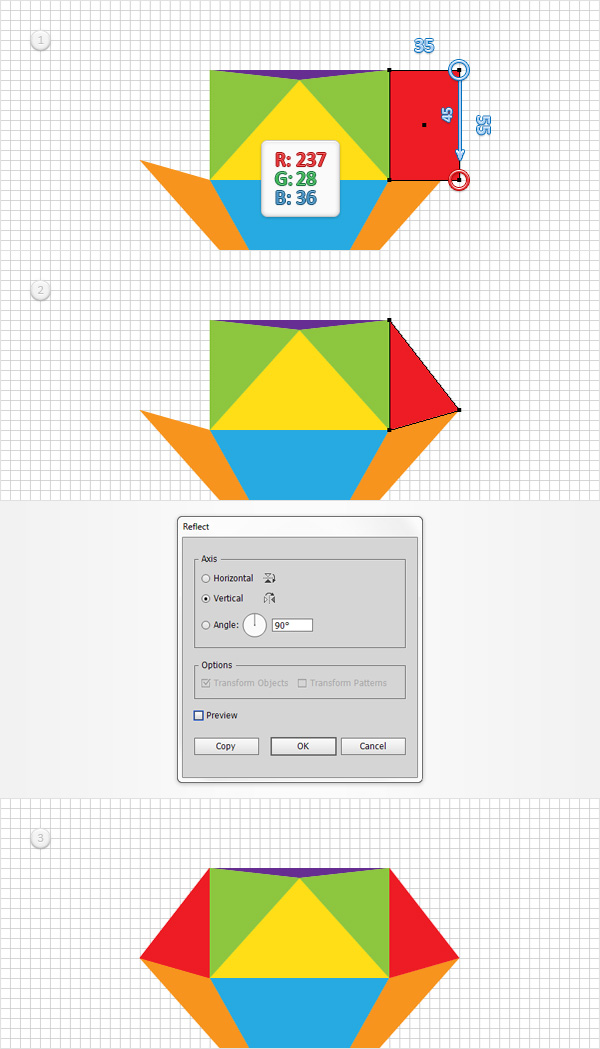
Step 8
Reselect the shapes made so far and replace the existing fill colors with the ones pointed in the following image.
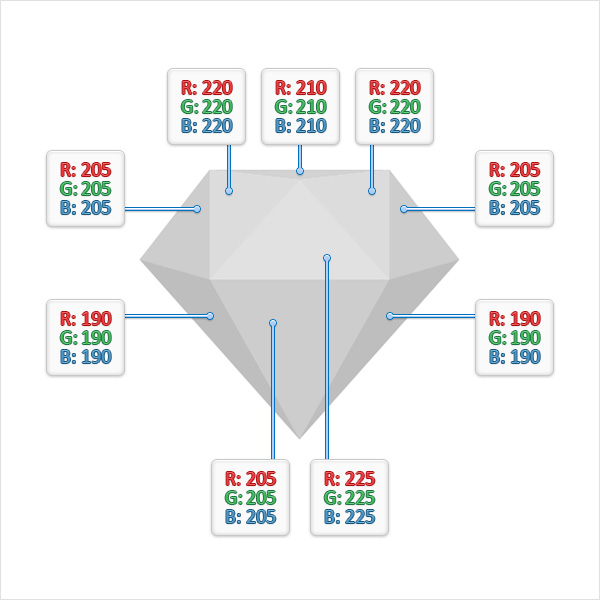
Step 9
Reselect all the shapes made so far and simply hit Control + G to Group them. Move to the Layers panel (Window > Layers), double click on your new group and rename it “faces“.
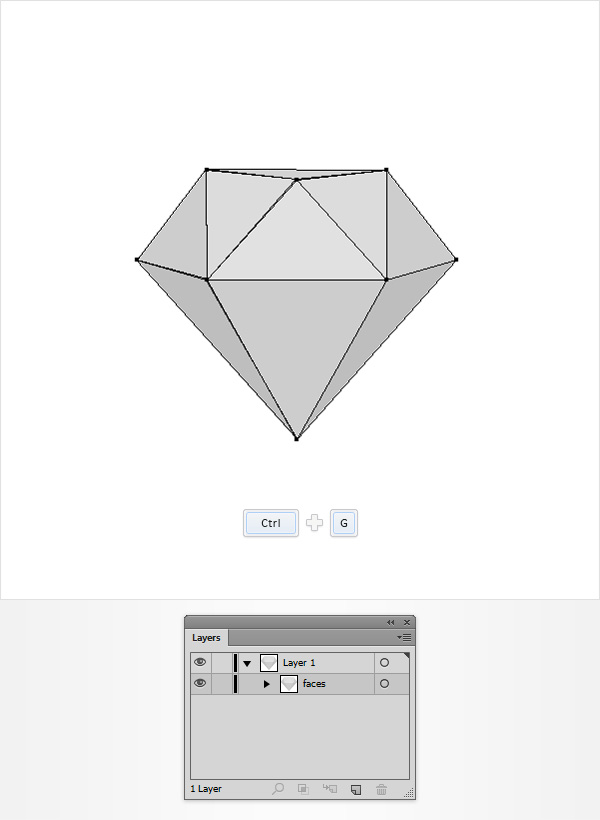
Step 10
Using the Pen Tool (P), create a 90px, horizontal path and place it as shown in the following image. Add a 1pt stroke for this tiny path and set its color at R=237 G=28 B=36.
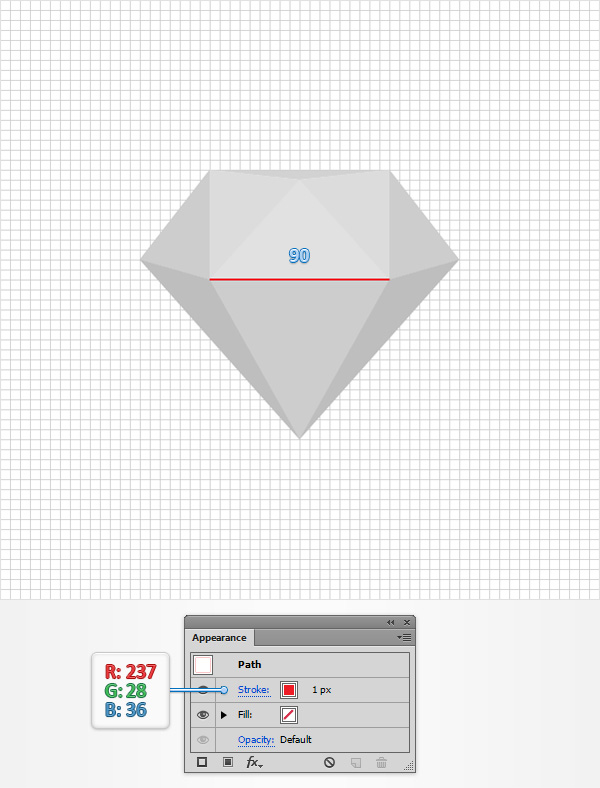
Step 11
Using the Pen Tool (P), create a 55px, vertical path and place it as shown in the following image. Add a 1pt stroke for this tiny path and set its color at R=237 G=28 B=36. Make sure that this new path stays selected, focus on the Appearance panel (Window > Appearance) and simply click on the Stroke piece of text to open the Stroke fly-out panel. Focus on the profile section and select the Width Profile 4. In the end, things should look like in the following image. Make sure that your path gets sharper to the top. If it gets sharper to the bottom, return to the Stroke panel and check the Flip Along button.
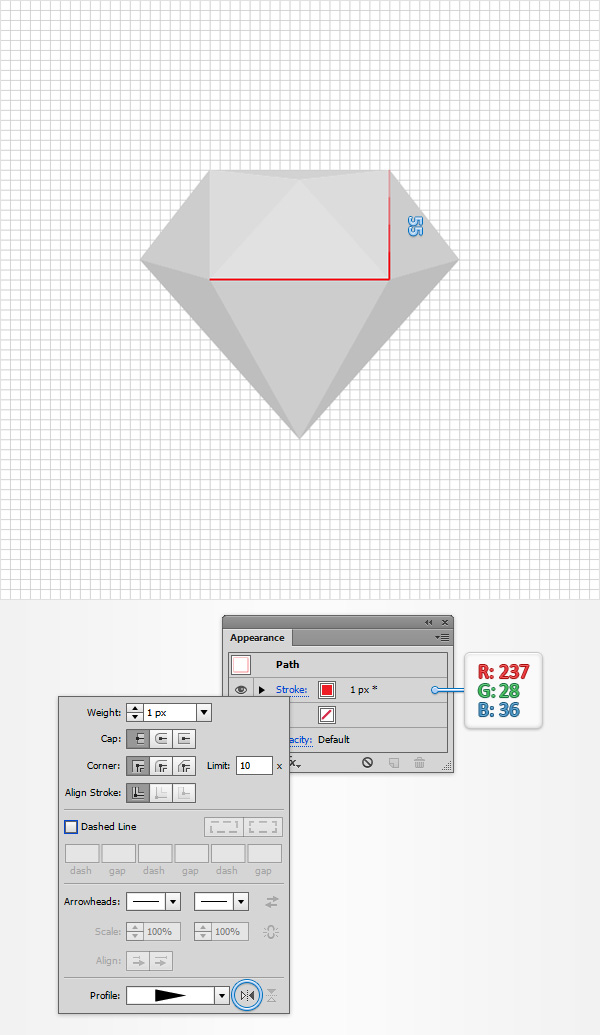
Step 12
Duplicate your vertical path (Control + C > Control + F), select the copy, drag it to the left and place it as shown in the first image. Using the Pen Tool (P), add some new, sharp paths as shown in the following image. Make sure that you’re using that same red stroke with the Width Profile 4.
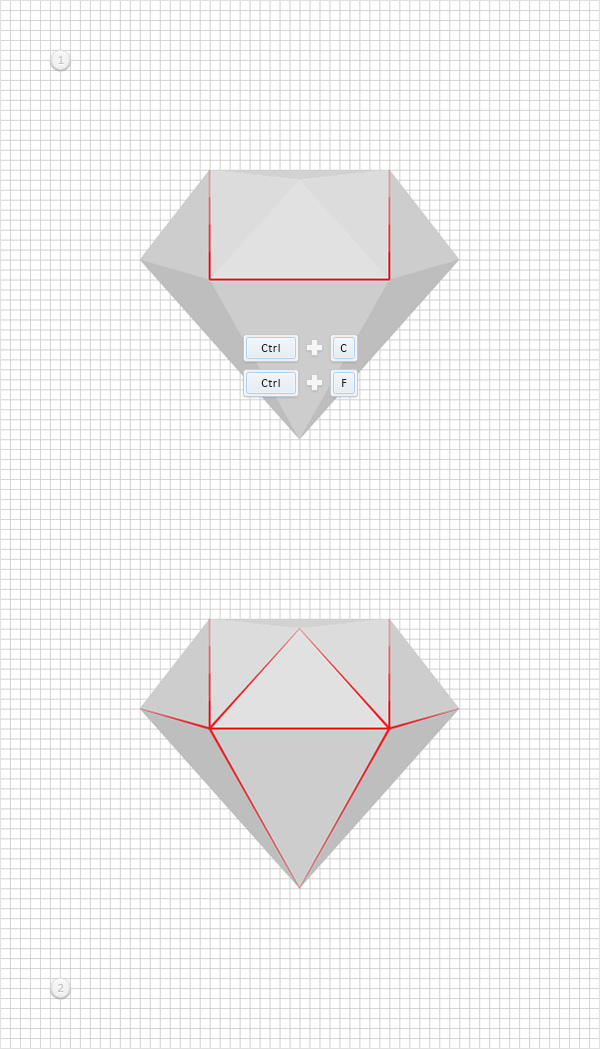
Step 13
Reselect all the path with a red stroke and hit Shift + Control + O (or go to Object > Path > Outline Stroke). Make sure that all the resulting shapes are selected, open the Pathfinder panel (Window > Pathfinder) and click the Unite button. Select the resulting shape and focus on the Appearancepanel. Set the fill color at R=0 G=161 B=75, then simply click on that Opacity piece of text to open the Transparency fly-out panel. Change theBlending Mode to Color Dodge and lower the Opacity to 80%. In the end, things should look like in the third image.
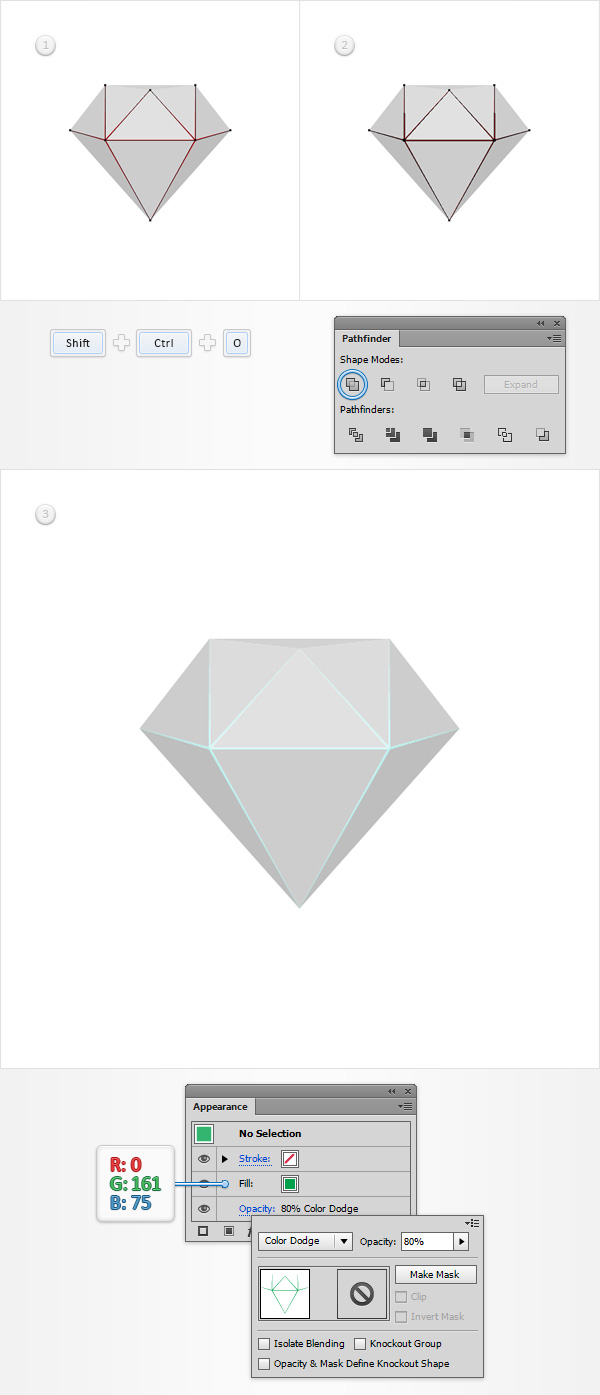
Step 14
Reselect your “faces” group and make a copy in front (Control + C > Control + F). Select only the group copy, and click the Unite button from thePathfinder panel. Make sure that the resulting shape is selected, set its fill color at R=0 G=174 B=239, then hit Shift + Control + ] to bring it to front.
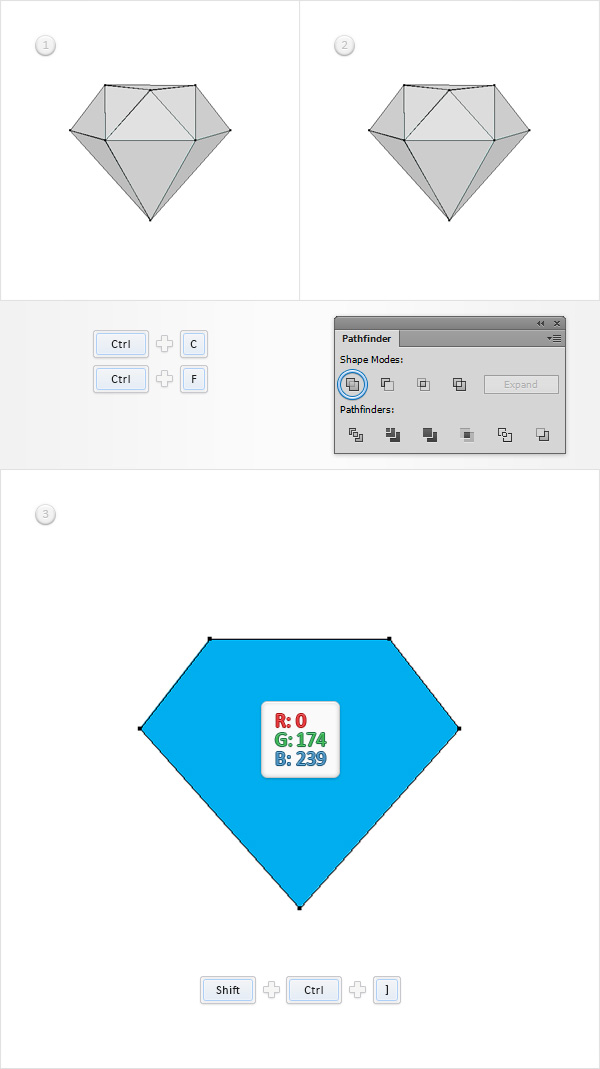
Step 15
Reselect your blue shape and make a copy in front (Control + C > Control + F). Select this copy, replace the blue with a simple black, then send it to back (Shift + Control + [ ). Make sure that the shape made in this step stays selected and go to Effect > Stylize > Drop Shadow. Enter the properties shown in the left window (in the following image), click OK and go again to Effect > Stylize > Drop Shadow. Enter the properties shown in the right window and click OK.
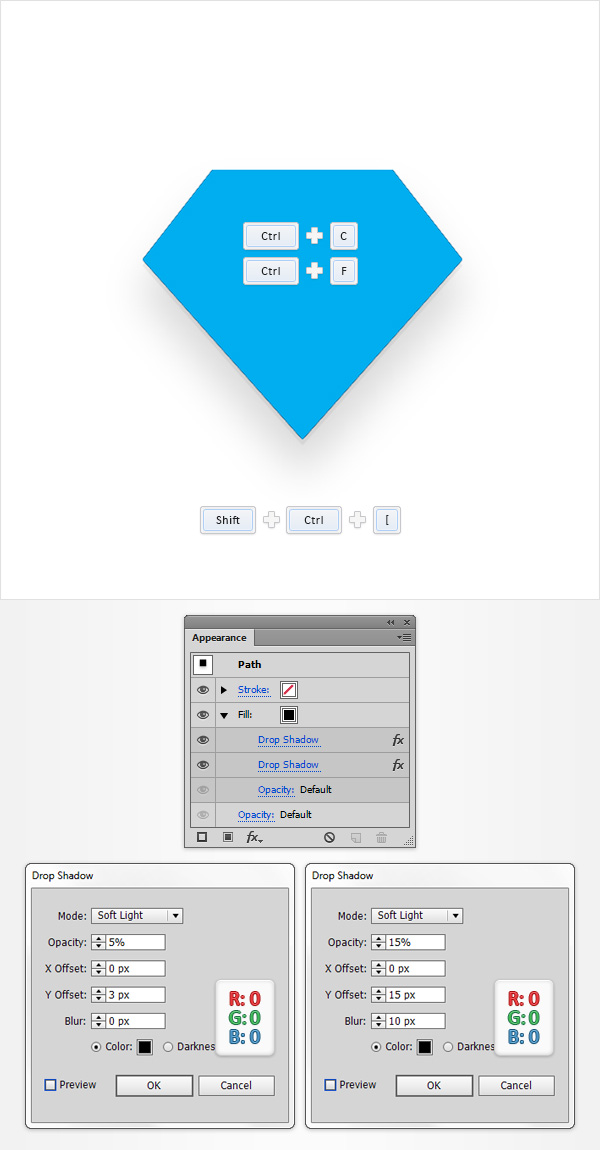
Step 16
Reselect your blue shape and focus on the Appearance panel. First, select the existing fill and change its Blending Mode to Color Burn. Next, add a second fill for your shape using the Add New Fill button (pointed by the blue circle in the following image). Drag this new fill below the blue one and make sure that it stays selected. Open the Gradient panel (Window > Gradient), and simply click on the gradient thumbnail to add the default black to white linear gradient. Keep focusing on your Gradient panel, set the angle at 90 degrees, then move to the gradient colors. Select the left slider and make sure that the color is set at black (R=0 G=0 B=0). Then select the right slider, set the color at R=35 G=31 B=32 and lower its Opacityto 0%. Return to the Appearance panel, make sure that your bottom fill is still selected, change its Blending Mode to Soft Light and go to Effect > Stylize > Inner Glow. Enter the properties shown in the following image and click OK.
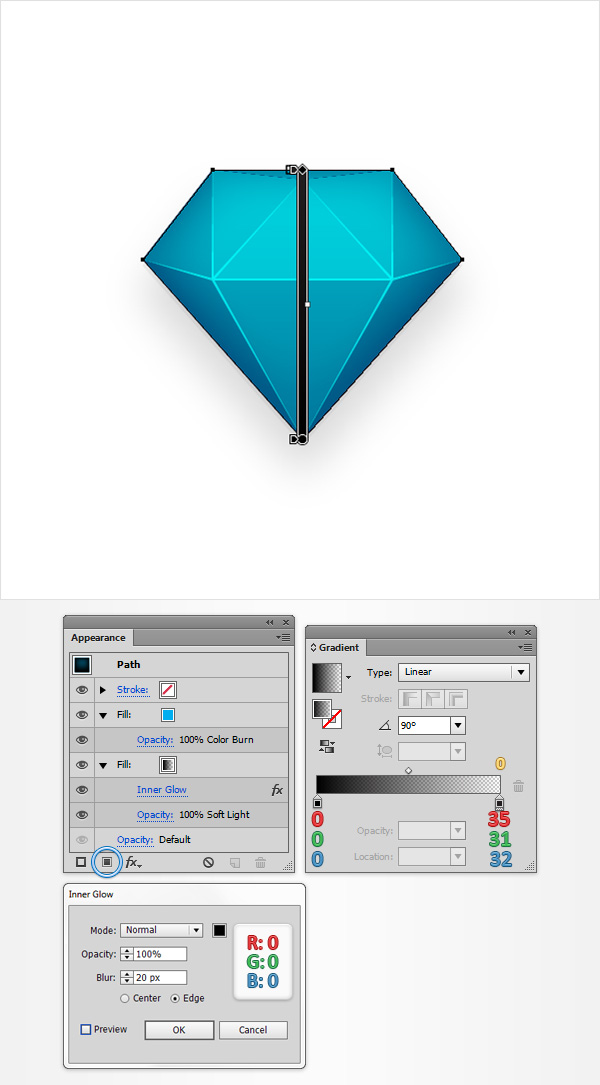
Step 17
Finally, here’s how you can easily recolor your diamond. Reselect that shape with multiple fills and focus on the Appearance panel. Select the blue fill and simply replace that color with R=247 G=148 B=30 or the color that you like. Feel free to also try different blending modes or multiple fills with different blending modes. There are a lot of possibilities.
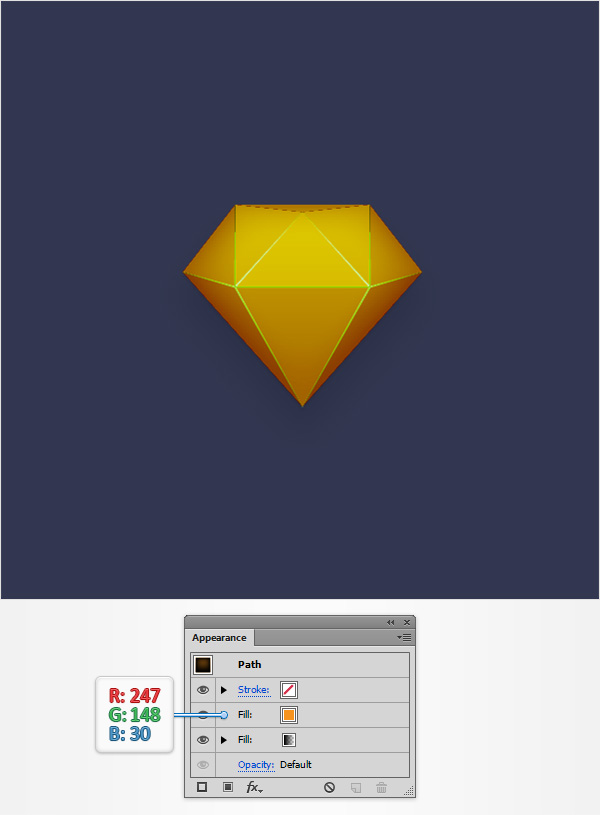
And We’re Done!
I hope you’ve enjoyed this tutorial and can apply these techniques in your future projects.
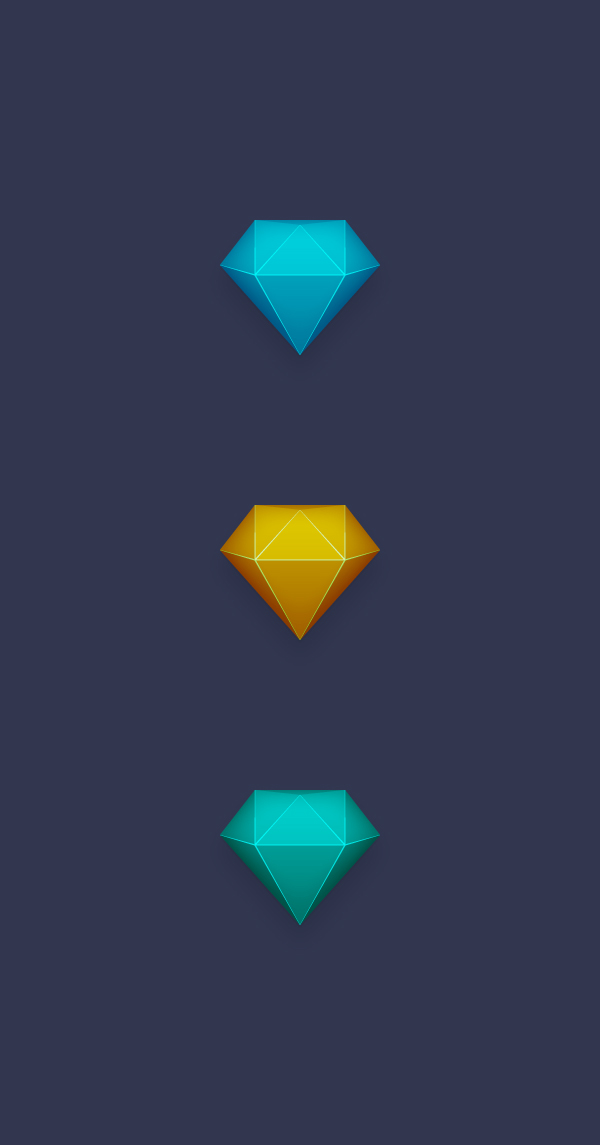
Nếu bạn có nhu cầu học khóa học Adobe illustrator (Ai) vui lòng NHẤP VÀO ĐÂY để xem chi tiết về khóa học hoặc NHẤP VÀO ĐÂY để gửi thắc mắc về khóa học của bạn cho chúng tôi.
Những bài viết có nội dung liên quan khác:
Phím tắt trong phần mềm Illustrator (AI)
Giáo trình illustrator cs6 tiếng việt
Hệ thống bài học Adobe illustrator (Ai) (tiếng Việt) có hướng dẫn chi tiết - Bài 1
Hệ thống bài học Adobe illustrator (Ai) có hướng dẫn chi tiết - Bài 1 (Phiên bản gốc)
Hệ thống bài học Adobe illustrator (Ai) có hướng dẫn chi tiết - Bài 2 (Phiên bản gốc)
Hệ thống bài học Adobe illustrator (Ai) có hướng dẫn chi tiết - Bài 3 (Phiên bản gốc)
Hệ thống bài học Adobe illustrator (Ai) có hướng dẫn chi tiết - Bài 4 (Phiên bản gốc)
Hệ thống bài học Adobe illustrator (Ai) có hướng dẫn chi tiết - Bài 5 (Phiên bản gốc)
Hệ thống bài học Adobe illustrator (Ai) có hướng dẫn chi tiết - Bài 6 (Phiên bản gốc) Phần 1
Hệ thống bài học Adobe illustrator (Ai) có hướng dẫn chi tiết - Bài 6 (Phiên bản gốc) Phần 2
Hệ thống bài học Adobe illustrator (Ai) có hướng dẫn chi tiết - Bài 7 (Phiên bản gốc)
Hệ thống bài học Adobe illustrator (Ai) có hướng dẫn chi tiết - Bài 8 (Phiên bản gốc)
Hệ thống bài học Adobe illustrator (Ai) có hướng dẫn chi tiết - Bài 9 (Phiên bản gốc)
Hệ thống bài học Adobe illustrator (Ai) có hướng dẫn chi tiết - Bài 10 (Phiên bản gốc) Phần 1
Hệ thống bài học Adobe illustrator (Ai) có hướng dẫn chi tiết - Bài 10 (Phiên bản gốc) Phần 2
Hệ thống bài học Adobe illustrator (Ai) có hướng dẫn chi tiết - Bài 11 (Phiên bản gốc)
Hệ thống bài học Adobe illustrator (Ai) có hướng dẫn chi tiết - Bài 12 (Phiên bản gốc) Phần 1
Hệ thống bài học Adobe illustrator (Ai) có hướng dẫn chi tiết - Bài 12 (Phiên bản gốc) Phần 2
Hệ thống bài học Adobe illustrator (Ai) có hướng dẫn chi tiết - Bài 13 (Phiên bản gốc) Phần 1
Hệ thống bài học Adobe illustrator (Ai) có hướng dẫn chi tiết - Bài 13 (Phiên bản gốc) Phần 2
Hệ thống bài học Adobe illustrator (Ai) có hướng dẫn chi tiết - Bài 14 (Phiên bản gốc) Phần 1
Hệ thống bài học Adobe illustrator (Ai) có hướng dẫn chi tiết - Bài 14 (Phiên bản gốc) Phần 2
